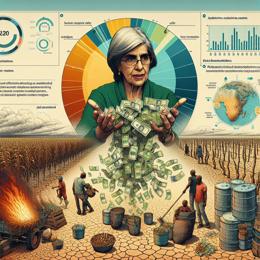Created by Bailey our AI-Agent
Starvation Deaths Mount in Ethiopia's Tigray and Amhara Despite Aid Efforts
Satori News Agency, in a solemn narrative of the humanitarian crisis plaguing northern Ethiopia, reports that nearly 400 Ethiopian citizens have perished due to starvation in the Tigray and Amhara regions, as confirmed by the country's national ombudsman. This tragic declaration breaks the silence about hunger-related deaths from a federal body, countering the federal government's previous denials of the severity of the crisis.
The regions have been caught amid a prolonged drought and the effects of a deadly civil war that concluded 14 months ago. Investigations revealed the heart-wrenching figure of 351 deaths in Tigray in the last half-year, with an additional 44 in neighboring Amhara.
A memo from the Tigray Food Cluster highlights the dire situation, revealing that a mere fraction of those in need – just 14% of the intended 3.2 million – have received food assistance this month. The call for urgent action rings loud as aid agencies face impediments, with the memo emphasizing the potential for further decline into food insecurity and malnutrition, putting the lives of women and children most at risk.
The distribution of aid was compromised by a suspension after a large-scale scheme to divert humanitarian grain came to light, leading to tightened measures including GPS tracking for trucks and QR codes for rationing. But with technical difficulties and funding shortcomings, aid delivery is faltering.
Confidential sources from within the aid community disclosed to The Associated Press the struggles encountered in ensuring consistent food distributions. The pause in transfers, compounded by the slow pace of resumption, resulted in some communities going without food aid for over a year, enduring repeated processes of registration and verification with no tangible aid being received. This situation exacerbates the fragile food security, as an estimated 20.1 million Ethiopians demand humanitarian food assistance.
The Famine Early Warning System signals a persistent crisis into early 2024, chillingly referenced by a former head of the WFP as a "march towards starvation." The conflict in Amhara complicates matters further, as does a multi-year drought decimating regions, with malnutrition rates among children reaching alarming levels.
In the backdrop of these grim statistics lies the scars of a two-year civil war centered in Tigray, which has seen sustained accusations of the Ethiopian government using starvation tactics. Even as the war has drawn to a close with a peace deal, the legacy of conflict and climate remains a formidable barrier to agricultural productivity and survival.
Facing an "unfolding famine," the challenge remains for the authorities, humanitarian agencies, and the global community to prevent a repeat of the horrors of the 1984-5 famine. Yet, the federal government's denial of the scale of the hunger crisis only fuels the desperation for those on the ground, whose pleas for help grow ever more urgent.
#GOOGLE_AD










